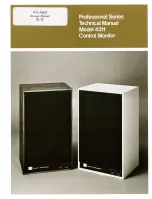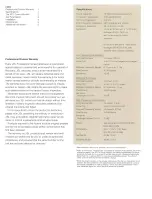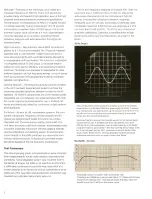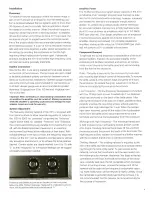
Midrange —
Transition to the midrange unit is made at a
crossover frequency of 1500 Hz. The 5-inch transducer
provides clarity and freedom from distortion, even at the high
loudness levels encountered in professional applications.
The transducer is energized by an Alnico V magnet housed
in a closed assembly having a total weight of 2.75 pounds
and creating a magnetic field of 16,500 gauss. The %-inch
diameter copper voice coil drives a 4-inch, edge-damped
cone that operates as a true piston, providing smooth
frequency response and wide dispersion throughout its
operating range.
High Frequency-
Reproduction above 6000 Hz is accom-
plished by a 1.4-inch direct radiator. Its 1.6-pound magnetic
assembly and %-inch diameter copper voice coil drive a
cone and center dome with controlled linearity assured by
an impregnated cloth termination. The voice coil, suspended
in a magnetic field of 15,000 gauss, is unusually large in
relation to cone size for efficiency and exceptional transient
response. The small cone diameter is responsible for wide,
uniform dispersion of high frequency energy: a ring of dense
foam surrounds the moving assembly to damp unwanted
radiation and reflections.
Dividing Network—The
frequency dividing network installed
in the 4311 has been designed and tested to achieve the
smoothest possible transitions between component loud-
speakers. All network components are of the highest quality.
Capacitors are non-inductive, non-polarized types with high
AC current capacity built expressly for use in dividing net-
works and individually tested for conformity to rigid perform-
ance standards.
Enclosure —
As with all JBL loudspeaker systems, the c o m -
ponent transducers, frequency dividing network and en-
closure are designed and tested to function as a single,
integrated unit. The enclosure is solidly constructed of %-
inch stock throughout with lock-mitered, wood-welded joints
to prevent unwanted resonance. Internal padding absorbs
spurious reflections and standing waves. All components
mount directly to the baffle panel and are removable from
the front of the enclosure. A ducted port provides proper
acoustical loading of the low frequency loudspeaker.
Test P a r a m e t e r s
The accompanying graph and specifications were compiled
from measurements made under standard laboratory test
conditions. The loudspeaker system was mounted flush in
the center of a large, flat baffle in an anechoic environment:
a calibrated condenser microphone was suspended at a
known distance from the sound source, sufficiently far to be
safely out of the near field; and all electronic equipment was
checked and calibrated before tests were run.
The on-axis frequency response of a typical 4311 does not
vary more than ± 3 dB from 45 to 15,000 Hz. Due to the
wide-angle characteristics of the midrange and high fre-
quency units and their physical orientation, response
measured up to 45° off-axis, horizontally or vertically, does
not deviate more than 6 dB from on-axis response at 2 kHz
nor more than 10 dB at 8 kHz. The 4311s lack of distortion
is equally outstanding. Distortion is inaudible even at high
power levels and at very low frequencies, as shown in the
photo.
35-Hz
Output
This unretouched photo shows the acoustic output of the system
when driven by a 50-Watt RMS sine wave signal at 35 Hz A labora-
tory microphone was used to pick up the sound from the 4311. The
signal from the microphone was connected directly to an oscillo-
scope and the trace photographed.
Sustained performance at this intensity would not be encountered
during normal use. A 50-Watt sine wave represents a far more
difficult job for the loudspeaker than its rated capacity of 50 Watts
program material, particularly in the very low frequency range. Even
so. it can be seen that the 4311 produces an almost perfect sine
wave. (Note: Below 50 Hz, most loudspeaker systems produce
substantial distortion with an input of only a few Watts.)
Response contour of system with controls set "flat'.'
(Presence and Brilliance controls each set at "5'.') Measured on-axis
response of a typical 4311, including all peaks and dips, does not
deviate more than 3 d B from the above curve.
3
Bandwidth —On-Axis








